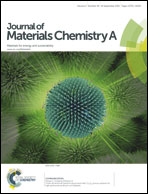Fluorescent polymeric ionic liquids for the detection of nitroaromatic explosives†
Abstract
We report, for the first time, applicability of film forming polymeric ionic liquids (PILs) possessing pyrene and anthracene fluorophores for the detection of nitroaromatics (NACs). These functionalized PILs were synthesized via post modification of thermo-chemically and mechanically stable polybenzimidazole (PBI). Formed PILs were evaluated for their ability to detect NACs through quenching of fluorescence intensity. Quenching of fluorescence intensity in solution state for NACs, such as nitrobenzene (NB), 2,4,6-trinitrotoluene (TNT) and picric acid (PA), was found to be rapid in both the PILs possessing pyrene and anthracene. The solution-phase Stern–Volmer quenching constants for PA were higher than for other NACs. After these promising results, self-standing films (∼12 μm thick) were also evaluated for fluorescence quenching by NACs as well as possible interferents of different nature. These films also exhibited rapid and selective fluorescence quenching when exposed to the saturated vapors of NACs at ambient temperature and pressure. Fluorescence emission of PIL films was affected little by the presence of commonly found interferents. Furthermore, fluorescence intensity could be recovered after the quenching, enabling the reuse of these PIL films for detection of NACs. Smart performance of these films and ease of preparation qualify them as attractive candidates in developing sensor devices for sensitive NACs detection in presence of possible interferents.


 Please wait while we load your content...
Please wait while we load your content...